Titan sub: Rescue shifts to recovery as OceanGate says five explorers ‘sadly lost’
A former business partner of Stockton Rush, the Titanic sub pilot, has revealed his views on safety and called for an investigation into “what went wrong”.
World
Don't miss out on the headlines from World. Followed categories will be added to My News.
The former business partner of Titanic submersible pilot Stockton Rush said on Friday that they put safety first when they co-founded their deep-sea exploration company.
Titanic movie director James Cameron has accused OceanGate Expeditions of ignoring safety warnings, after Rush and four other people were lost in a “catastrophic implosion” while descending to the shipwreck.
Guillermo Soehnlein, who started OceanGate with Rush before leaving the company in 2013, said he was not involved in the design of the Titan submersible, but denied his old friend was reckless.
“He was extremely committed to safety,” he told Britain’s Times Radio.
“He was also extremely diligent about managing risks, and was very keenly aware of the dangers of operating in a deep ocean environment.
“So that’s one of the main reasons I agreed to go into business with him in 2009.”
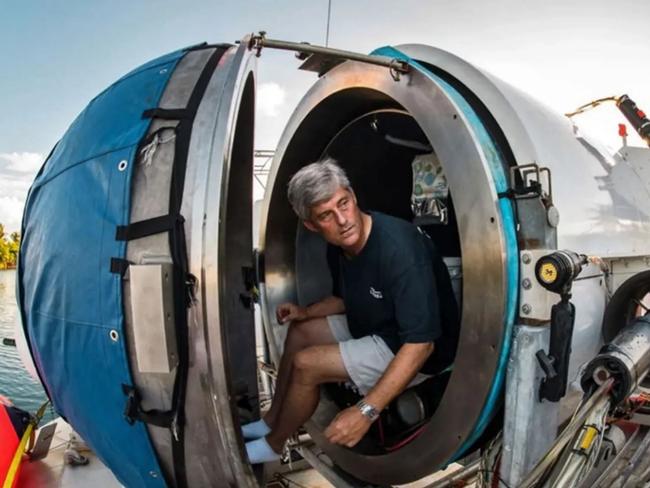
Soehnlein noted that Cameron himself had conducted many submersible descents, including more than 30 to the Titanic site in the North Atlantic, and to the Earth’s deepest point in the Pacific Mariana Trench.
“I think he was asked about a similar risk and he said, ‘look, if something happens at that depth, it will be catastrophic in a matter of microseconds.’”
“To the point where the implosion happens at almost supersonic speeds and you’d basically be dead before your brain could even process that anything was wrong.”
Soehnlein stressed, however, that it was too soon to say what happened to the Titan, and that it was “tricky to navigate” to formulate global regulations for submersibles designed to go ultra deep.
But deep-sea exploration should continue despite the tragedy, he said.
“Just like with space exploration, the best way to preserve the memories and the legacies of these five explorers is to conduct an investigation, find out what went wrong, take lessons learned and then move forward.”
BODIES OF TITAN CREW MAY NEVER BE RECOVERED
The bodies of the crew aboard the Titanic submersible may never be recovered from the “unforgiving” ocean where they died, the US Coast Guard said.
Debris of the missing Titan submarine was discovered 487 metres (1600 feet) from the bow of the Titanic, with all five explorers on board confirmed dead.
US Coast Guard Rear Admiral John Mauger said there were no survivors after the tail cone of the OceanGate submersible was found by a search and rescue remote operating vehicle.
“The debris is consistent with the catastrophic loss of the pressure chamber. Upon this determination, we immediately notified the families,” he said.
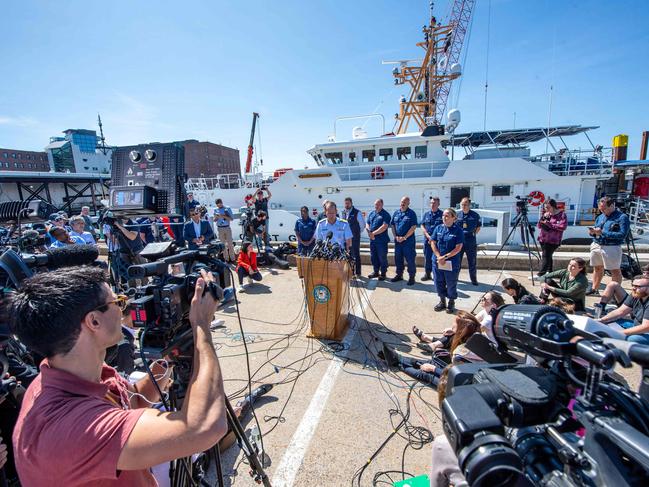
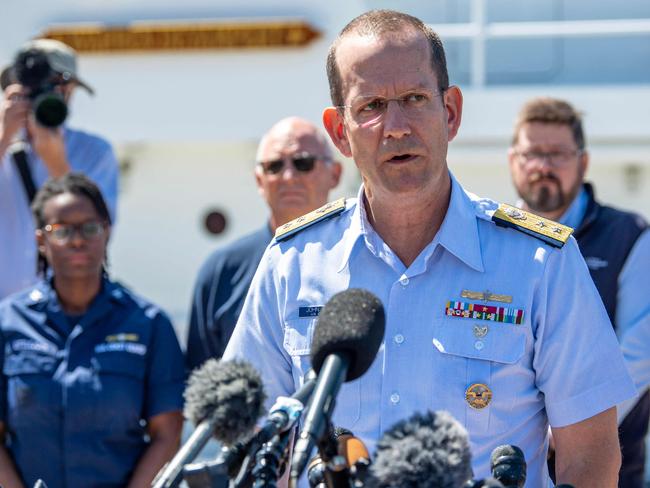
“We offer our deepest condolences,” he added.
“I can only imagine what this has been like for them, and I hope that this discovery provides some solace during this difficult time.”
While it was unclear precisely when the Titan suffered a “catastrophic implosion”, Mr Mauger said it was before the US Coast Guard launched search and rescue efforts that have detected the event through its sonar buoys.
The Pelagic Research Services ROV that found the debris field was deployed from the Canadian vessel Horizon Arctic and arrived at the sea floor about 9pm Thursday AEST, when oxygen supplies would have expired had the submersible not imploded.
After the tail cone was first discovered, a total of five different pieces of debris were found in two separate debris fields.
The first and largest area contained the front of the pressure hull, and a second, smaller debris field contained the other half of the pressure hull.
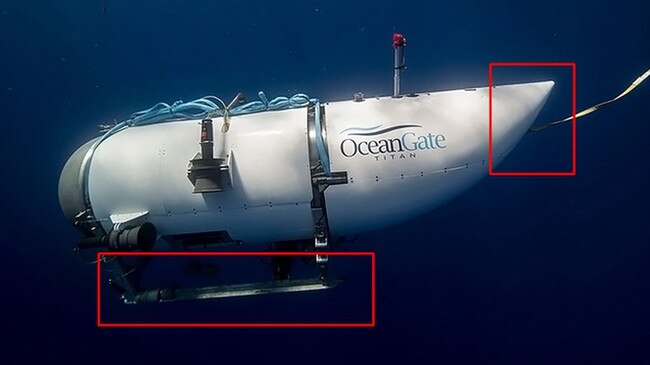
Mr Mauger said he was unsure if they could recover the bodies of British billionaire Hamish Harding, Pakistani businessman Shahzada Dawood and son Suleman, French explorer Paul-Henri Nargeolet, and OceanGate Expeditions CEO Stockton Rush.
“This is an incredibly unforgiving environment down there on the sea floor and the debris is consistent with a catastrophic implosion of the vessel,” he said.
“We’ll continue to work and continue to search the area down there, but I don’t have an answer for prospects [of recovering the bodies].”

Carl Hartsfield, an expert with the Woods Hole Oceanographic Institution, said the tourist submarine imploded before reaching the wreckage of the Titanic, rather than colliding or getting tangled in the massive ship.
“It’s in an area where there is not any debris from the Titanic. It is a smooth bottom. There’s no Titanic wreckage from that area, 200-plus meters from the bow and consistent with the location of the last communication for an implosion,” he said.

Despite the frantic search over the past four days, Mr Mauger said there was no evidence the sounds heard beneath the surface were connected to the vessel, or that potential delays in the search and rescue efforts played any role in the tragedy.
“The debris field is consistent with a catastrophic implosion of the vessel, while we were prosecuting the search we had listening devices in the water throughout and did not hear any signs of catastrophic failure,” he said.
OceanGate said Thursday that it believes the passengers of the Titanic-bound submersible have “sadly been lost”.
“These men were true explorers who shared a distinct spirit of adventure, and a deep passion for exploring and protecting the world’s oceans,” the company said in a statement.
“Our hearts are with these five souls and every member of their families during this tragic time. We grieve the loss of life and joy they brought to everyone they knew.”
“This is an extremely sad time for our dedicated employees who are exhausted and grieving deeply over this loss.”
‘LANDING FRAME AND REAR COVER’ CONFIRMED
A rescue expert and friend of two missing Titanic sub passengers confirmed a debris field discovered in the search and rescue effort included a “landing frame and rear cover” from the OceanGate vessel.
In a live interview on Sky News, David Mearns received a text message he said revealed the pieces of debris found on the ocean floor included distinct features from the unique submersible.
“It was a landing frame and a rear cover from the submersible, so again this is a very unconventional submarine,” he said.
“That rear cover is the pointy end of it, and the landing frame is the little frame that it seems to sit on, and that’s how it gets docked” he added. “So that confirms that it’s the submersible.”
Earlier, the US Coast Guard announced the discovery of a “debris field” in the search area and that experts were analysing the material.
‘IT WOULD HAVE BEEN IMMEDIATE, MILLISECONDS’: RESCUE EXPERT
Mr Mearns, a friend of British billionaire Hamish Harding and French explorer Paul-Henri Nargeolet said the confirmation of the Titan debris came from the ships involved in search and rescue efforts.
“There’s a WhatsApp group between ourselves and the Explorers Club that we’ve all been connected to as soon as this happened, and our president is directly connected to the ships that are out there,” Mr Mearns said.
“It means the hull hasn’t yet been found but two very important parts of the whole system have been discovered and that would not be found unless it was fragmented.”
“My worst fears as of Monday have now been realised,” he added. “So yeah, two friends of mine are gone.”
The seeming confirmation of the Titan wreckage came shortly after Mr Mearns said the US Coast Guard wouldn't use phrases like debris field “unless there’s no chance of a recovery of the men alive”.
“A debris field implies a break-up of the submersible … that really sort of indicates what is the worst-case scenario, which is a catastrophic failure and generally that’s an implosion,” he said.
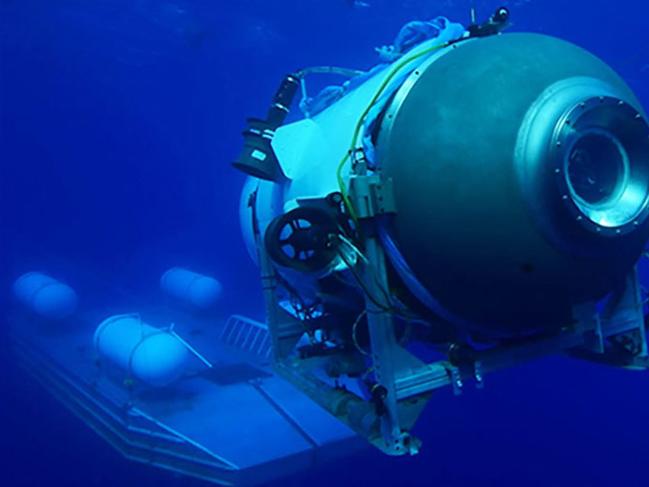
“The only saving grace is that it would have been immediate – literally in milliseconds – and the men wouldn’t have known what was happening.”
“If the faring is off and the frame is off then something really bad has happened to the entire structure,” he added.
Sidonie Nargeolet, the daughter of renowned French diver Paul-Henri Nargeolet, told Reuters that she’s had mixed emotions about possibly losing her father while doing what he loved.
“If they are not found, it will be very sad for us because we will not see him again,” Ms Nargeolet, 39, said.
“What he liked the most was to be in a submarine, (near) the Titanic. He is where he really loved being. I would prefer him (dying) at a place where he is very happy.”
If the debris is confirmed to be from Titan wreckage, the search and rescue mission will shift to a recovery effort and an investigation into what caused the potential failure of the submarine.
‘OFF-THE-SHELF TECH USED TO SAVE MONEY’, SUB DEVELOPER SAYS
Doug Virnig, who helped develop the Titan, told CNN before the discovery of the debris that OceanGate used off-the-shelf technology in an effort to save on research and development costs.
“It seems kind of cheesy, but if you knew the amount of technology that was packed in that controller and its capabilities, and the amount of money that it costs to develop something like that, it’s just off the charts,” he told the news network of the video game controller.
“So if you can take these components off the shelf and incorporate them into a project like this, where you don’t have the research and development timelines and expense, that I believe is a wise choice.”
But Mr Virnig added that OceanGate had “gone cutting edge where they needed to” and “incorporated a good bit of conventional wisdom” into the development of the submersible.
‘TRAGIC LOSS’: RESCUE CREWS SHIFT FOCUS
The company that discovered the debris field at the bottom of the Atlantic said its focus has turned from search and rescue to a ‘tragic loss’.
Pelagic Research Services, which confirmed to CNN its remotely operated vehicle discovered the debris field near the Titanic, posted a statement which has since been deleted saying its “focus right now is on the families of those on the Titan and for their tragic loss”.
“Pelagic Research Services (PRS) was contacted by OceanGate Expeditions to provide critical support in the rescue operation of the submersible Titan in the North Atlantic,” the website said.
“Our sincere thoughts, hopes, and prayers are with all the families, friends, and rescue personnel of those affected by this tragedy.”
While debris has been found in the search area, there has been no official confirmation of any deaths.
EXPERTS SCRAMBLE AT SIGNS OF SUB
The US Coast Guard announced the discovery of a “debris field” within the search area of the Titanic.
“Experts within the unified command are evaluating the information,” the coast guard said.
The debris was detected by a remotely operated vehicle equipped with cameras and sonar, which reached the sea floor as expected supplies of oxygen on the submarine were thought to have expired.
2/2 Information for the next press briefing can be found here: https://t.co/WyQ3pWZfiM
— USCGNortheast (@USCGNortheast) June 22, 2023
The discovery came after deep-sea search and rescue equipment arrived to join the last-ditch effort to find the missing Titan vessel carrying British billionaire Hamish Harding, Pakistani businessman Shahzada Dawood and son Suleman, French explorer Paul-Henri Nargeolet, and OceanGate Expeditions CEO Stockton Rush.
DEBRIS DISCOVERED AS OXYGEN EXPIRED
The debris field was announced almost six hours after the Titan’s 96-hours of oxygen supplies were expected to run out at roughly 9pm AEST on Thursday.
Mr Harding’s cousin, Kathleen Cosnett, said before the discovery that an eight-hour delay in notifying authorities of the missing submarine was “frightening”.
The OceanGate vessel wasn’t reported missing until about eight hours after it lost contact with its mothership, the Polar Prince.
‘It’s very frightening. It took so long for them to get going to rescue them, it’s far too long. I would have thought three hours would be the bare minimum,” she told the UK’s Telegraph.
She added it was “worrying” the five passengers “may not have any extra oxygen left” as heavy-duty rescue equipment arrived on the fourth day of the search and rescue operation.
If the debris field is confirmed as belonging to the Titan, however, it could suggest a sudden catastrophic failure to the vessel rather than a slow wait on the seabed for a rescue that never arrived.
DEBRIS DISCOVERY ‘GRIM NEWS’
Admiral Sir James Burnell-Nugent, former Commander-in-Chief Fleet of the Royal Navy, told Sky News the announcement suggests the debris is connected with the Titan rather than the Titanic, which covers several hectares.
“I think on balance this is probably grim news and suggests the Titan might have imploded under the immense pressure of the seawater while it was on its way down,” he said.
Rear Admiral John Mauger and Captain Jamie Frederick of the US Coast Guard will hold a press conference at 5am AEST to provide more information on the debris field.
The ROV that found the debris field is believed to have reached the sea floor about 9pm AEST Thursday after being deployed from the Canadian vessel Horizon Arctic.
The Canadian vessel Horizon Arctic has deployed an ROV that has reached the sea floor and began its search for the missing sub. #Titanic
— USCGNortheast (@USCGNortheast) June 22, 2023
SEARCH STILL A RESCUE MISSION
As hopes fade that the five crew members trapped on the missing Titanic sub will be found alive, the US Coast Guard has insisted the search is still a “rescue mission”.
Rescue teams are still hoping for a miracle as a high-tech underwater robot has hit the ocean floor to scour for the stricken sub.
The US Coast Guard’s Rear Admiral John Mauger, who is heading the search operation, said rescuers remain focused on finding the five-member crew alive.
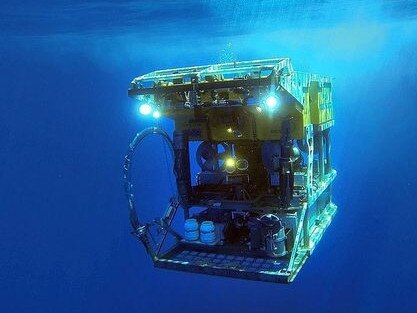
Rear Admiral Mauger said the operation “remains an active search” and he “remains hopeful” thanks to “favourable” weather conditions. Asked about the banging noises, he said initial analysis suggested they were “background ocean noise” but this was still being examined.
The robotic vessels used in the search have started to make some headway, with one reaching the sea floor, according to the US Coast Guard’s Northeast division.
The Canadian vessel Horizon Arctic has deployed an ROV that has reached the sea floor and began its search for the missing sub. #Titanic
— USCGNortheast (@USCGNortheast) June 22, 2023
Search crews have been frantically looking for the vessel in the Atlantic in a tense race against the clock after it lost communication on Sunday with just 96 hours of life support.
The US Coastguard warned the oxygen supply was due to run out at 9.08pm last night – meaning it is probable the crew on board Titan are now without breathable air.
Experts say humans can only survive a few minutes without oxygen.
Along with the French deep-sea diving robot Victor 6000, it was also announced that a British Royal Navy submariner would also join the search mission.

‘TOUGH DECISION’ LIKELY AS HOPE FADES
But as hopes of finding the five passengers alive aboard the stricken submarine Titan are fading, the US Coast Guard could make the “tough decision” to switch from a search and rescue mission to a vessel recovery effort.
A US Coast Guard spokeswoman had earlier estimated the last vestiges of the Titan’s oxygen supply could have lasted until 7.08am Thursday local time (9.08pm AET), but even that deadline presumed regular breath intake by the passengers, which was far from assured given the circumstances.
It comes as a second air search team reported hearing noises from the sea on Wednesday morning, after the crew of a Canadian plane reported banging sounds on Tuesday. The noises were reportedly heard at 30 minute intervals.
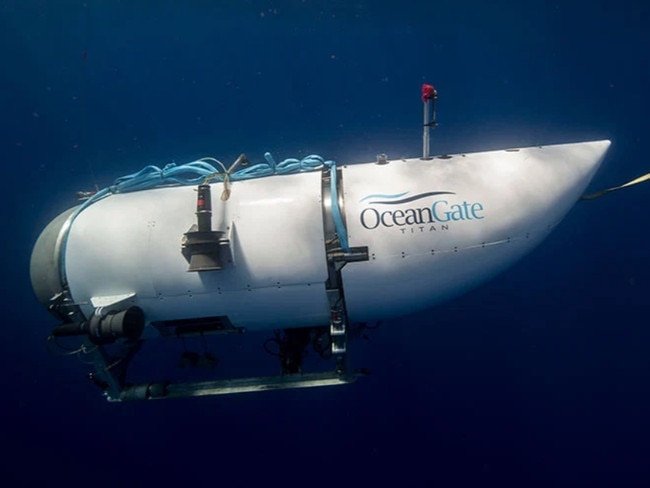
The world’s most advanced underwater search equipment and multiple crews from the US, Canada and France were unable to find any trace of the 21-foot (6.4 metre) vessel, which lost contact with its support ship one hour and 45 minutes into its descent down to the wreck of the Titanic on Sunday.
Ten ships had joined the mission as of Wednesday, with efforts continuing through the night, to locate the vessel which could be up to 4000 metres below the ocean’s surface.
Search teams had been using an array of cutting-edge technology in their rescue attempts, including the Victor 6000, a robot able to dive 6000 metres beneath the ocean surface, and Odysseus 6k, a remotely-operated vehicle capable of reaching the same depths.
Coast Guard Captain Jamie Frederick did not speculate about the next phase of the mission when briefing the media on Wednesday, saying they may have to make “a tough decision” but stressing “We’re not there yet”.
With regard to the noises heard by aircrew, Capt Frederick said “we don’t know what they are, to be frank with you,” but search efforts had been focused on the area from where the noises emanated.
Carl Hartsfield, of the Woods Hole Oceanographic Institution, said it was not clear what the banging noises were.
“There are biological sounds that sound man-made to the untrained ear … There are a lot of vessels in the area and they each make noise,” he said.
Former Royal Navy submarine commander Andy Coles said it was entirely possible the passengers had died from hypothermia or carbon dioxide poisoning, long before the Thursday morning oxygen deadline.
As more and more questions were asked about the safety of the OceanGate Expeditions vessel, Mr Coles was one of several commentators who remarked on the seeming lack of carbon dioxide scrubbers on board the Titan.
A carbon dioxide scrubber is a device for removing CO2 from the air – essential for any enclosed space such as a submarine.
“I don’t think the submarine has any means of cleaning out the CO2 and recirculating the air,” Mr Coles told The Mirror.
“So [the passengers] will probably go to sleep way before they don’t fully suffocate. The other thing to also consider is 3800 metres down, it’s incredibly cold.”
Mr Coles said it could take two months to retrieve the Titan, even once it was located.
“You might be able to get them up in the future. You know, in two months’ time, you might get the lifting kit there, everything you need in place,” the Mirror quoted him as saying.
—Reporting with AFP




